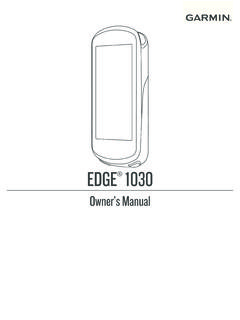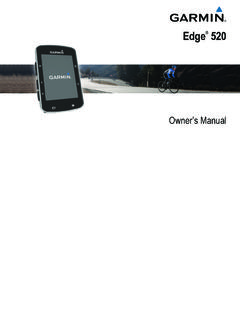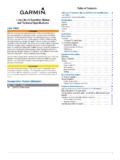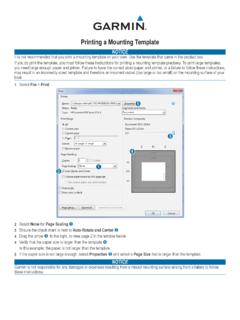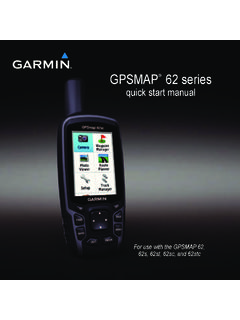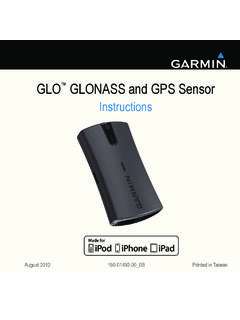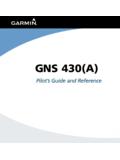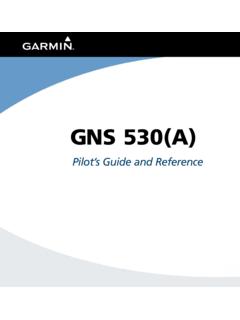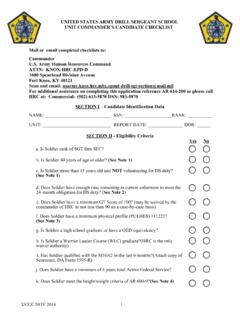Transcription of GT36UHD/GT56UHD Transducers Installation Instructions
1 GT36 UHD/GT56 UHD TRANSDUCERSINSTALLATION INSTRUCTIONSI mportant Safety Information WARNINGSee the Important Safety and Product Information guide in the chartplotter or fishfinder product box for product warnings and other important are responsible for the safe and prudent operation of your vessel. Sonar is a tool that enhances your awareness of the water beneath your boat. It does not relieve you of the responsibility of observing the water around your boat as you navigate. CAUTIONF ailure to install and maintain this equipment in accordance with these Instructions could result in damage or avoid possible personal injury, always wear safety goggles, ear protection, and a dust mask when drilling, cutting, or drilling or cutting, always check what is on the opposite side of the surface to avoid damaging the obtain the best performance and to avoid damage to your boat, you must install the Garmin device according to these all Installation Instructions before proceeding with the Installation .
2 If you experience difficulty during the Installation , go to for more UpdateYou must update the Garmin chartplotter software when you install this device. For Instructions on updating the software, see your chartplotter owner's manual at Needed Number 2 Phillips screwdriverTransom mount drill drill bits: 4 mm (5/32 in.), mm (1/8 in.), 25 mm (1 in.) Masking tape Marine sealantTrolling motor mount Waterproof tapeMounting ConsiderationsTo ensure peak performance with the lowest noise and interference, you should route the transducer cable away from ignition wires, house batteries and wires, trolling motor batteries and wires, and high-energy wires such as radar, audio amplifier, and autopilot pump your transducer cable is not long enough to reach the chartplotter, you can add an extension cable (Garmin part number 010-11617-42 or 010-11617-32, not included).
3 To avoid signal degradation, do not extend the cable more than 9 m (30 ft.).Preparing the transducer for Long-Term Exposure to WaterNOTICEDo not use acetone or acetone-based products on the transducer . Acetone damages the plastic transducer you install a transducer on a boat that spends a significant amount of time in the water, you should coat the transducer and mounting hardware with a water-based anti-fouling paint to prevent marine sand the transducer and mounting hardware with a fine-grit abrasive the transducer and mounting hardware with isopropyl water-based anti-fouling paint to the transducer and mounting the transducer on a TransomMounting Location Considerations The transducer should be mounted parallel to the water line.
4 The transducer should extend mm ( in.) below a fiberglass hull or 10 mm ( in.) below an aluminum hull . On boats with outboard or inboard/outboard motors, the transducer should be mounted as close to the centerline of the transom as possible but at least 38 cm (15 in.) from the propeller . If your propeller moves clockwise when the boat moves, the transducer should be mounted on the starboard side (right side when facing forward). If your propeller moves counter-clockwise when the boat moves, the transducer should be mounted on the port side (left side when facing forward). The transducer should not be mounted behind strakes, struts, fittings, water intake or discharge ports, or anything that creates air bubbles or causes the water to become v2 February 2021 The transducer must be in clean (non-turbulent) water for optimal performance.
5 On single-drive boats, the transducer must not be mounted in the path of the transducer can cause cavitation that can degrade the performance of the boat and damage the propeller. On twin-drive boats, the transducer should be mounted between the drives, if possible. Mount the transducer cable cover well above the water line . Apply marine sealant to all screw threads to prevent water from seeping into the transom . This transducer has an integrated spray guard, but if your transducer throws an excessive amount of water spray, recheck these mounting considerations and adjust the position of the transducer as needed to eliminate the the transducer with a Transom Mount Bracket1 Attach the mount to the transducer with the included star washers , and screws.
6 2 Attach the mount to the bracket with the bolt , flat washer , rubber washer , and lock nut .NOTE: The bolt should be tight enough to hold the transducer in place when the boat moves at high speed, but loose enough to allow the transducer to pivot out of the way if the transducer hits an the Transom-Mount HardwareNOTICEIf you are mounting the bracket on fiberglass with screws, it is recommended to use a countersink bit to drill a clearance counterbore through only the top gel-coat layer. This will help to avoid cracking in the gel-coat layer when the screws are cables connected to the transducer should not be cut, because cutting the transducer cables voids your an Installation location on the transom (Mounting Location Considerations, page 1).
7 2 Cut out the the template aligned vertically on the transom at the Installation location (Mounting Location Considerations, page 1), place the bottom corner of the template on the edge of the the center location of the two holes of the the template from the a piece of tape around a 4 mm (5/32 in.) bit at 18 mm (7/10 in.) from the point of the bit, to avoid drilling the pilot holes too you are installing the bracket on fiberglass, place a piece of tape over the pilot-hole location to reduce cracking of the gel the 4 mm (5/32 in.) bit, drill the pilot holes approximately 18 mm (7/10 in.) deep at the marked marine sealant to the included 20 mm screws, and attach the transducer assembly to the the cable under the transom mount cable you must route the cable through the transom, choose a pilot-hole location well above the waterline and mark a cable clamp on the transducer cable, approximately halfway between the transducer and the top of the transom or the pass-through pilot the pilot-hole location for the cable clamp, and using a mm (1/8 in.)
8 Bit, drill a pilot hole approximately 10 mm (3/8 in.) marine sealant to the included 12 mm screw, and attach the cable clamp to the you marked a pilot hole in step 11, use a 25 mm (1 in.) drill bit to drill a pass-through hole completely through the the transducer cable to the chartplotter: If you are routing the cable using a pass-through hole, push it through the pass-through hole, and install the cable-entry cover (Installing the Cable-Entry Cover, page 2). If you are not routing the cable using a pass-through hole, route the cable up and over the top of the should avoid routing the cable close to electrical wires or other sources of electrical the Cable-Entry CoverIf you routed the cable through the transom after you installed the transducer , you should install the cable-entry cover to keep water from entering your the cable-entry cover over the hole and the cable, with the opening pointing downward, and mark the location of the two pilot the cable-entry cover, and, using a mm (1/8 in.)
9 Bit, drill the pilot holes approximately 10 mm (3/8 in.) the pass-through hole with marine sealant so it covers the cable completely and there is excess sealant around the hole and the the cable-entry cover over the hole and the cable, with the opening pointing marine sealant to the included 12 mm M4 screws, and attach the cable-entry cover to the away all excess marine the InstallationNOTICEYou should check your boat for leaks before you leave it in the water for an extended period of water is necessary to carry the sonar signal, the transducer must be in the water to work properly. You cannot get a depth or distance reading when out of the water.
10 When you place your boat in the water, check for leaks around any screw holes that were added below the water the Transom-Mount transducer InstallationNOTICEWhen adjusting the depth of the transducer , make the adjustments in small increments. Placing the transducer too deep can adversely affect the performance of the boat and put the transducer at risk of striking underwater the transom-mount transducer Installation in open water free of obstacles. Pay attention to your surroundings as you test the the boat in the water, turn on the the boat at a slow speed. If the chartplotter appears to be working properly, gradually increase speed while observing the the sonar signal is suddenly lost or the bottom return is severely degraded, note the speed at which this the boat to the speed at which the signal was lost, and make moderate turns in both directions while observing the the signal strength improves while turning, adjust the transducer so that it extends another 1/8 in.
